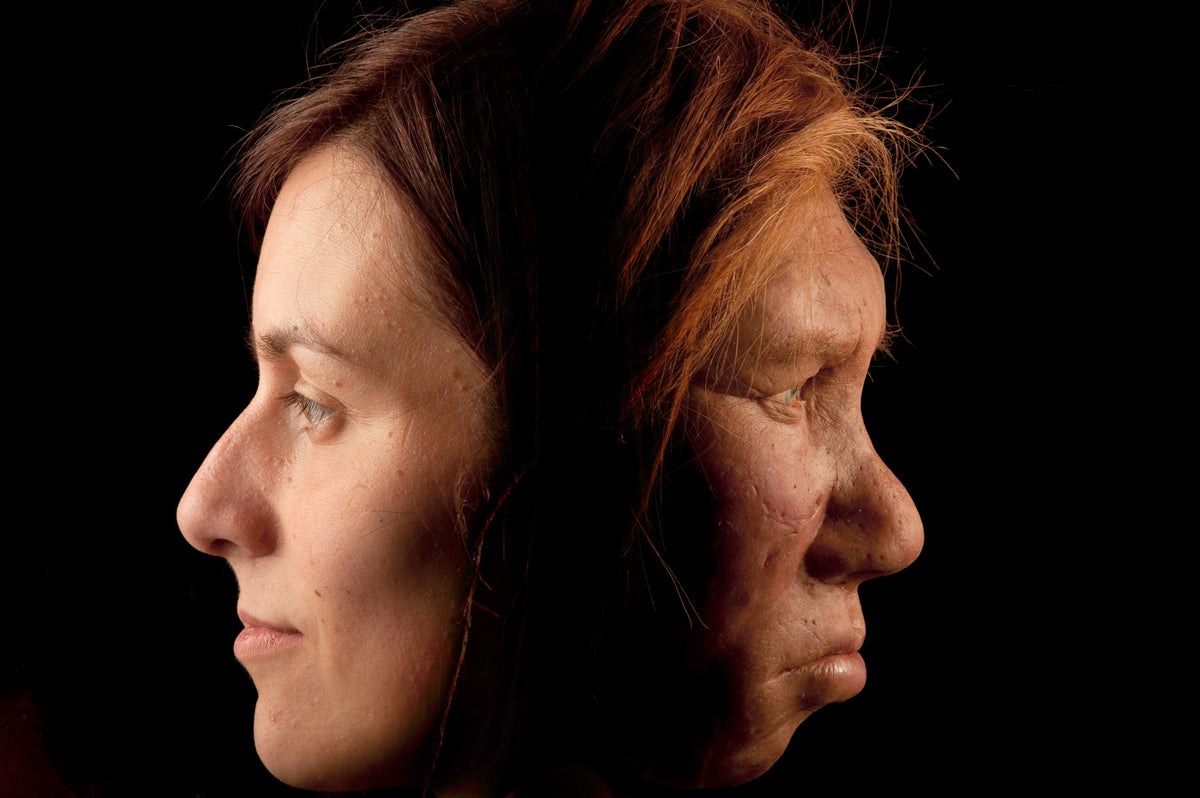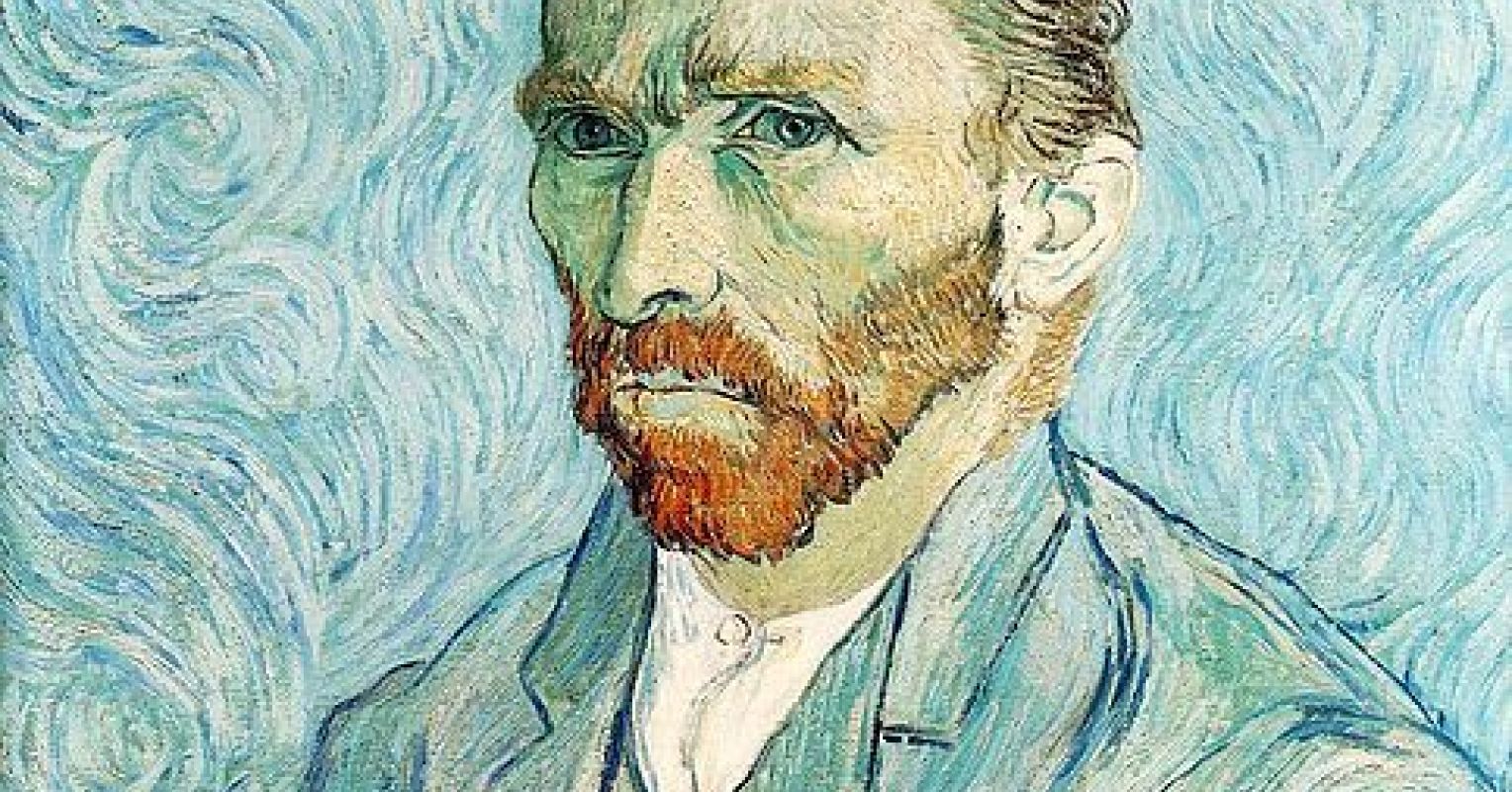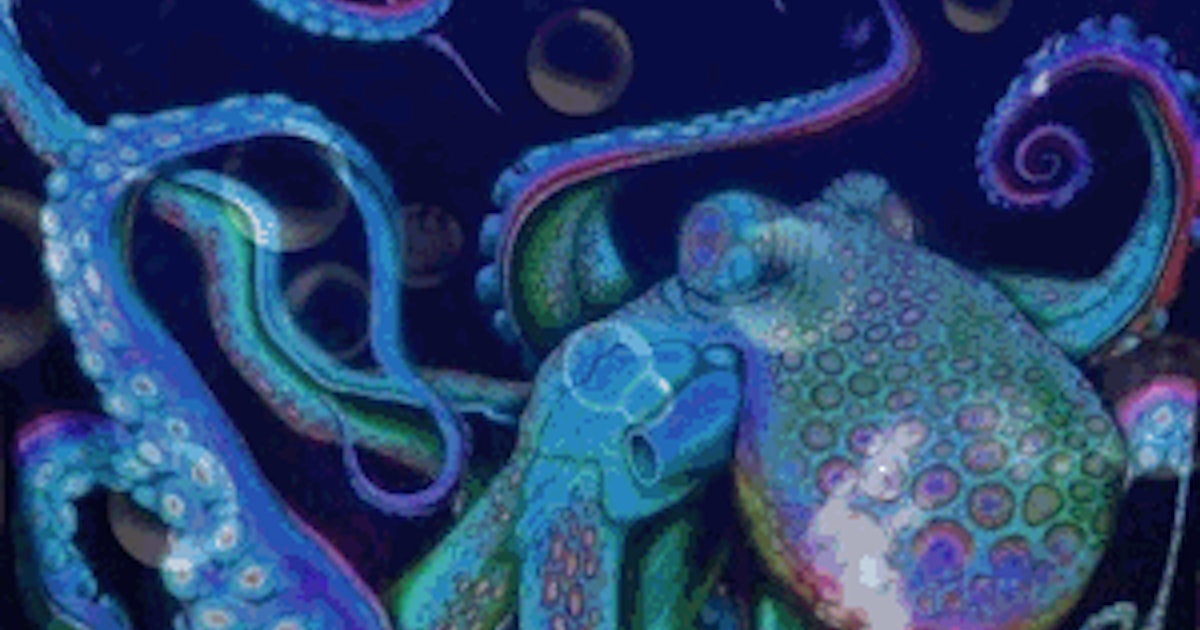And dogs often eat cat poop, which is not a sign of intelligence. Something to remember when I see a vet bill for hundreds of dollars 
You are using an out of date browser. It may not display this or other websites correctly.
You should upgrade or use an alternative browser.
You should upgrade or use an alternative browser.
- Thread starter Daniel E.
- Start date
More threads by Daniel E.

It has been hypothesized that the earliest life on Earth may have used PNA as a genetic material due to its extreme robustness, simpler formation, and possible spontaneous polymerization at 100 °C[11] (while water at standard pressure boils at this temperature, water at high pressure—as in deep ocean—boils at higher temperatures). If this is so, life evolved to a DNA/RNA-based system only at a later stage.[12][13] Evidence for this PNA world hypothesis is, however, far from conclusive.[14] If it existed though, it must have preceded the widely accepted RNA world.

"For most of human history, we're not dissimilar to any other wild primate. We're manipulating our environments, but not on a scale bigger than, say, a herd of African elephants. And then, we go into partnership with this group of wolves. They altered our relationship with the natural world." — Greger Larson
With wolves digging dens long before humans constructed huts it is not clear who domesticated whom.[66][62][91]
Homelessness among people with mental health problems is 'much less common' in China than in high-income countries, due to stronger family ties, but is increasing due to migration within families and as a result of the one-child policy. A study in Xiangtan found at least 2439 schizophrenic people that have been homeless on a total population of 2.8 million. It was found that "homelessness was more common in individuals from rural communities (where social support services are limited), among those who wander away from their communities (i.e., those not from Xiangtan municipality), and among those with limited education (who are less able to mobilize social supports). Homelessness was also associated with greater age; [the cause] may be that older patients have ‘burned their bridges’ with relatives and, thus, end up on the streets."

While Freud's ideas concerning children mostly came from working with adult patients, Klein was innovative in working directly with children, often as young as two years old. Klein saw children's play as their primary mode of emotional communication. While observing children play with toys such as dolls, animals, plasticine, pencil and paper, Klein documented their activities and interactions, then attempted to interpret the unconscious meaning behind their play. Following Freud she emphasized the significant role that parental figures played in the child's fantasy life, and considered that the timing of Freud's Oedipus complex was incorrect. Contradicting Freud, she concluded that the superego was present from birth.
After exploring ultra-aggressive fantasies of hate, envy, and greed in very young and disturbed children, Melanie Klein proposed a model of the human psyche that linked significant oscillations of state, with the postulated Eros or Thanatos pulsations. She named the state of the psyche in which the sustaining principle of life is in domination the depressive position. This is considered by many to be her great contribution to psychoanalytic thought. She later developed her ideas about an earlier developmental psychological state corresponding to the disintegrating tendency of life, which she called the paranoid-schizoid position.
Discovery Date: 1908
Where Lived: Europe; possibly Asia (China); Africa (eastern and southern)
When Lived: About 700,000 to 200,000 years ago
This early human species had a very large browridge, and a larger braincase and flatter face than older early human species. It was the first early human species to live in colder climates; their short, wide bodies were likely an adaptation to conserving heat. It lived at the time of the oldest definite control of fire and use of wooden spears, and it was the first early human species to routinely hunt large animals. This early human also broke new ground; it was the first species to build shelters, creating simple dwellings out of wood and rock...
Comparison of Neanderthal and modern human DNA suggests that the two lineages diverged from a common ancestor, most likely Homo heidelbergensis, sometime between 350,000 and 400,000 years ago – with the European branch leading to H. neanderthalensis and the African branch (sometimes called Homo rhodesiensis) to H. sapiens.

 www.scientificamerican.com
www.scientificamerican.com
In part, thanks to self-awareness, we can summon autobiographical memories, go on mental journeys to the past and future, and make predictions based on knowledge that lets us devise innovative plans. A conscious awareness of who we are gives us the ability to tell ourselves apart from others and put ourselves in their shoes. In short, it enables us to be creative in our thinking.

Although the popular tendency has been to see the December 1914 Christmas Truces as unique and of romantic rather than political significance, they have also been interpreted as part of the widespread spirit of non-co-operation with the war.[63] In his book on trench warfare, Tony Ashworth described the 'live and let live system'. Complicated local truces and agreements not to fire at each other were negotiated by men along the front throughout the war. These often began with agreement not to attack each other at tea, meal or washing times. In some places tacit agreements became so common that sections of the front would see few casualties for extended periods of time. This system, Ashworth argues, 'gave soldiers some control over the conditions of their existence'.[64] The December 1914 Christmas Truces then can be seen as not unique, but as the most dramatic example of spirit of non-co-operation with the war that included refusal to fight, unofficial truces, mutinies, strikes, and peace protests.

 www.psychologytoday.com
www.psychologytoday.com
Van Gogh sold only one painting in his lifetime and died at the age of 37, before he would see any success. His mother threw away crates filled with his work but did live long enough to possibly regret it as he was ultimately hailed as a genius. He is now considered the greatest Dutch painter after Rembrandt.
But while the bad part-object certainly exists, so also does the good part-object. When splitting is overcome and ambivalence (Klein's misnamed "depressive position") achieved, when the forces of love (Eros) are dominant over the forces of envy and hate (Thanatos), these part-objects are integrated into a whole, creatively repaired, good object. Confidence in one's capacity to love and make reparation for one's hatred and destructiveness establishes this whole good object, identification with which makes possible an equally holistic and integrated sense of self. Though "fallen" and "broken" and perpetually falling back into paranoid-schizoid dynamics, the self comes to be experienced as capable of repairing and of being reparable and, hence, as fundamentally good. Here is the basis for an attitude of basic trust in the goodness of existence and of the self. This is the essence of a mature faith and is no illusion.

The FBI–King suicide letter or blackmail package was an anonymous 1964 letter and package by the Federal Bureau of Investigation (FBI) meant to blackmail Martin Luther King Jr.[1] The suicide letter was part of the FBI's COINTELPRO operation against King.
This tip, straight from celebrity food nerd Alton Brown, comes from an old 2010 Good Eats clip in which Brown shares his tips for making the perfect cup of coffee. His trick? Adding 1/4 teaspoon of kosher salt for every six tablespoons of coffee grounds he uses. “Not only does salt cut the bitterness of coffee, but it also smooths out the ‘stale’ taste of tank-stored water,” says Brown. “I’ve taken to adding a quarter teaspoon of kosher salt to every six tablespoons of grounds.”

 getpocket.com
getpocket.com
Serotonin — believed to help regulate mood, social behavior, sleep, and sexual desire — is an ancient neurotransmitter that’s shared across vertebrate and invertebrate species.

 www.vice.com
www.vice.com
In 1840, it was briefly cool to walk a turtle on a string around the Parisian arcades. “You did that to signal time abundance, to signal quite how little you did or how much leisure you had, because that was a sign of status,” said Tony Crabbe, a business psychologist and the author of Busy: How to Thrive in a World of Too Much.
:max_bytes(150000):strip_icc()/how-do-wild-birds-keep-warm-in-winter-386721-hero-c2ee8d6e39af469ba2d05167771d990d.jpg)
 www.thespruce.com
www.thespruce.com
Torpor is most common in smaller bird species in areas where food supplies can be unpredictable and nighttime conditions can be extreme. It is most common for birds using torpor to remain in their territories year-round, rather than migrating to areas with more food and more mild climates, but many different birds will use torpor for different conditions. Bird species that regularly use torpor include:

 www.eatthis.com
www.eatthis.com
The red sauce you've been dumping onto your pasta and pizza is very different from any kind of sauce you'll find on your Eurotrip.
Marinara sauce is tomato-heavy and, while tomatoes are on our list of foods you should eat every day, traditional Italian sauces are light on the tomato and heavy on other ingredients like olive oil and herbs. The result is a lighter dish with a more delicate flavor. If you can bear to part with your beloved marinara sauce, try ordering pasta "al Pomodoro" or spaghetti "alla puttanesca" to go authentic.

It has been hypothesized that the earliest life on Earth may have used PNA as a genetic material due to its extreme robustness, simpler formation, and possible spontaneous polymerization at 100 °C[11] (while water at standard pressure boils at this temperature, water at high pressure—as in deep ocean—boils at higher temperatures). If this is so, life evolved to a DNA/RNA-based system only at a later stage.[12][13] Evidence for this PNA world hypothesis is, however, far from conclusive.[14] If it existed though, it must have preceded the widely accepted RNA world.

"For most of human history, we're not dissimilar to any other wild primate. We're manipulating our environments, but not on a scale bigger than, say, a herd of African elephants. And then, we go into partnership with this group of wolves. They altered our relationship with the natural world." — Greger Larson
With wolves digging dens long before humans constructed huts it is not clear who domesticated whom.[66][62][91]
Last edited:
[noparse]https://www.figure1.com/post/the-be...-according-to-17-428-healthcare-professionals[/noparse] Link not found ~ admin
Patients receive the best care in the emergency room between 6 a.m. and noon, according to an exclusive poll of healthcare professionals around the world.

Patients receive the best care in the emergency room between 6 a.m. and noon, according to an exclusive poll of healthcare professionals around the world.

More homelessness in Australia, Canada, Sweden, and the Netherlands than in the US, China, India, or Brazil (per capita):
It is estimated that 150 million people are homeless worldwide. Habitat for Humanity estimated in 2015 that 1.6 billion people around the world live in "inadequate shelter".
This is a list of countries (not all 195) by the homeless population present on any given night. Different countries often use different definitions of homelessness, making direct comparisons of numbers complicated.
Last edited:
Homelessness among people with mental health problems is 'much less common' in China than in high-income countries, due to stronger family ties, but is increasing due to migration within families and as a result of the one-child policy. A study in Xiangtan found at least 2439 schizophrenic people that have been homeless on a total population of 2.8 million. It was found that "homelessness was more common in individuals from rural communities (where social support services are limited), among those who wander away from their communities (i.e., those not from Xiangtan municipality), and among those with limited education (who are less able to mobilize social supports). Homelessness was also associated with greater age; [the cause] may be that older patients have ‘burned their bridges’ with relatives and, thus, end up on the streets."

While Freud's ideas concerning children mostly came from working with adult patients, Klein was innovative in working directly with children, often as young as two years old. Klein saw children's play as their primary mode of emotional communication. While observing children play with toys such as dolls, animals, plasticine, pencil and paper, Klein documented their activities and interactions, then attempted to interpret the unconscious meaning behind their play. Following Freud she emphasized the significant role that parental figures played in the child's fantasy life, and considered that the timing of Freud's Oedipus complex was incorrect. Contradicting Freud, she concluded that the superego was present from birth.
After exploring ultra-aggressive fantasies of hate, envy, and greed in very young and disturbed children, Melanie Klein proposed a model of the human psyche that linked significant oscillations of state, with the postulated Eros or Thanatos pulsations. She named the state of the psyche in which the sustaining principle of life is in domination the depressive position. This is considered by many to be her great contribution to psychoanalytic thought. She later developed her ideas about an earlier developmental psychological state corresponding to the disintegrating tendency of life, which she called the paranoid-schizoid position.
Discovery Date: 1908
Where Lived: Europe; possibly Asia (China); Africa (eastern and southern)
When Lived: About 700,000 to 200,000 years ago
This early human species had a very large browridge, and a larger braincase and flatter face than older early human species. It was the first early human species to live in colder climates; their short, wide bodies were likely an adaptation to conserving heat. It lived at the time of the oldest definite control of fire and use of wooden spears, and it was the first early human species to routinely hunt large animals. This early human also broke new ground; it was the first species to build shelters, creating simple dwellings out of wood and rock...
Comparison of Neanderthal and modern human DNA suggests that the two lineages diverged from a common ancestor, most likely Homo heidelbergensis, sometime between 350,000 and 400,000 years ago – with the European branch leading to H. neanderthalensis and the African branch (sometimes called Homo rhodesiensis) to H. sapiens.
Last edited:

Genes Linked to Self-Awareness in Modern Humans Were Less Common in Neandertals
Brain networks for memory and planning may have set us apart from Neandertals—and chimps
In part, thanks to self-awareness, we can summon autobiographical memories, go on mental journeys to the past and future, and make predictions based on knowledge that lets us devise innovative plans. A conscious awareness of who we are gives us the ability to tell ourselves apart from others and put ourselves in their shoes. In short, it enables us to be creative in our thinking.
Last edited:

Although the popular tendency has been to see the December 1914 Christmas Truces as unique and of romantic rather than political significance, they have also been interpreted as part of the widespread spirit of non-co-operation with the war.[63] In his book on trench warfare, Tony Ashworth described the 'live and let live system'. Complicated local truces and agreements not to fire at each other were negotiated by men along the front throughout the war. These often began with agreement not to attack each other at tea, meal or washing times. In some places tacit agreements became so common that sections of the front would see few casualties for extended periods of time. This system, Ashworth argues, 'gave soldiers some control over the conditions of their existence'.[64] The December 1914 Christmas Truces then can be seen as not unique, but as the most dramatic example of spirit of non-co-operation with the war that included refusal to fight, unofficial truces, mutinies, strikes, and peace protests.

Vincent Van Gogh Was Likely a Synesthete
Vincent Van Gogh associated artistic technique and musical instruments...
Van Gogh sold only one painting in his lifetime and died at the age of 37, before he would see any success. His mother threw away crates filled with his work but did live long enough to possibly regret it as he was ultimately hailed as a genius. He is now considered the greatest Dutch painter after Rembrandt.

While Freud's ideas concerning children mostly came from working with adult patients, Klein was innovative in working directly with children, often as young as two years old. Klein saw children's play as their primary mode of emotional communication. While observing children play with toys such as dolls, animals, plasticine, pencil and paper, Klein documented their activities and interactions, then attempted to interpret the unconscious meaning behind their play. Following Freud she emphasized the significant role that parental figures played in the child's fantasy life, and considered that the timing of Freud's Oedipus complex was incorrect. Contradicting Freud, she concluded that the superego was present from birth.
After exploring ultra-aggressive fantasies of hate, envy, and greed in very young and disturbed children, Melanie Klein proposed a model of the human psyche that linked significant oscillations of state, with the postulated Eros or Thanatos pulsations. She named the state of the psyche in which the sustaining principle of life is in domination the depressive position. This is considered by many to be her great contribution to psychoanalytic thought. She later developed her ideas about an earlier developmental psychological state corresponding to the disintegrating tendency of life, which she called the paranoid-schizoid position.
But while the bad part-object certainly exists, so also does the good part-object. When splitting is overcome and ambivalence (Klein's misnamed "depressive position") achieved, when the forces of love (Eros) are dominant over the forces of envy and hate (Thanatos), these part-objects are integrated into a whole, creatively repaired, good object. Confidence in one's capacity to love and make reparation for one's hatred and destructiveness establishes this whole good object, identification with which makes possible an equally holistic and integrated sense of self. Though "fallen" and "broken" and perpetually falling back into paranoid-schizoid dynamics, the self comes to be experienced as capable of repairing and of being reparable and, hence, as fundamentally good. Here is the basis for an attitude of basic trust in the goodness of existence and of the self. This is the essence of a mature faith and is no illusion.
Last edited:

The FBI–King suicide letter or blackmail package was an anonymous 1964 letter and package by the Federal Bureau of Investigation (FBI) meant to blackmail Martin Luther King Jr.[1] The suicide letter was part of the FBI's COINTELPRO operation against King.
:extract_focal()/https%3A%2F%2Fpocket-syndicated-images.s3.amazonaws.com%2Farticles%2F5387%2F1597429505_k_Photo_Recipes_2019-09-how-to-shrimp-alfredo_HT-Shrimp-Alfredo_095.jpg)
Add a pinch of salt to your morning coffee [grounds] to make it taste less bitter.
This tip, straight from celebrity food nerd Alton Brown, comes from an old 2010 Good Eats clip in which Brown shares his tips for making the perfect cup of coffee. His trick? Adding 1/4 teaspoon of kosher salt for every six tablespoons of coffee grounds he uses. “Not only does salt cut the bitterness of coffee, but it also smooths out the ‘stale’ taste of tank-stored water,” says Brown. “I’ve taken to adding a quarter teaspoon of kosher salt to every six tablespoons of grounds.”
David Baxter PhD
Late Founder
That suggestion has been around for decades. I never found that it made any difference at all to the taste of the coffee (neither better nor worse). But it is a great way to add even more salt to your diet, which for most people already contains too much salt, and thereby to increase your risk for heart attacks and strokes.

Octopus MDMA Study Brings Light to the Evolution of Social Behavior
“They just embraced with multiple arms.”
Serotonin — believed to help regulate mood, social behavior, sleep, and sexual desire — is an ancient neurotransmitter that’s shared across vertebrate and invertebrate species.

The Cult of Busyness
A life of leisure was once the aspiration of the upper class. But now, bragging about busyness is how people indicate their status. Could a pandemic change the way busyness is glorified?
In 1840, it was briefly cool to walk a turtle on a string around the Parisian arcades. “You did that to signal time abundance, to signal quite how little you did or how much leisure you had, because that was a sign of status,” said Tony Crabbe, a business psychologist and the author of Busy: How to Thrive in a World of Too Much.
The above reminds me of the TV show Keeping Up Appearances. The wife tells her husband that he should look happy when gardening so people will think he is gardening for the pleasure (and not because he can't afford a gardener).
:max_bytes(150000):strip_icc()/how-do-wild-birds-keep-warm-in-winter-386721-hero-c2ee8d6e39af469ba2d05167771d990d.jpg)
Ever Wonder How Wild Birds Keep Warm in the Winter?
Do birds get cold? How do birds keep warm in winter? Learn how wild birds heat up and how to help them beat the cold.
Torpor is most common in smaller bird species in areas where food supplies can be unpredictable and nighttime conditions can be extreme. It is most common for birds using torpor to remain in their territories year-round, rather than migrating to areas with more food and more mild climates, but many different birds will use torpor for different conditions. Bird species that regularly use torpor include:
- Hummingbirds
- Poorwills
- Frogmouths
- Swifts
- Nighthawks
- Doves
- Chickadees
- Roadrunners

7 Foods You Won't Find In Authentic Italian Restaurants, According to Chefs
There are huge differences between the typical Italian foods you'll eat in the U.S. and what you'll see in authentic Italian restaurants.
The red sauce you've been dumping onto your pasta and pizza is very different from any kind of sauce you'll find on your Eurotrip.
Marinara sauce is tomato-heavy and, while tomatoes are on our list of foods you should eat every day, traditional Italian sauces are light on the tomato and heavy on other ingredients like olive oil and herbs. The result is a lighter dish with a more delicate flavor. If you can bear to part with your beloved marinara sauce, try ordering pasta "al Pomodoro" or spaghetti "alla puttanesca" to go authentic.
Replying is not possible. This forum is only available as an archive.
